
mcnutly and young : world contest, 1966
| home | catalogue | history | references | appendix |
 |
surfresearch.com.au
mcnutly and young : world contest, 1966 |
Copy
courtesy of the Graham Sorensen Collection.
"How's it feel to be World Champ a spectator asked as Robert "Nat" Young stood on the winner's platform, squinting into a battery of television cameras.
"Great! I feel jazzed," grinned the curly-haired Aussie, holding his shiny first-place trophy.
That was
the scene amid the tumut and the shouting on San Diego Ocean
Beach as the third World Surfing Championships faded into
the record book.
No one could
derail the "Nat Young express" and Young, 18, who had won
the Australian title at Coolangatta last June, had ripped
apart the California surf during the week long competition,
leaving no doubt among the 53 men contestants, 15 women,
officials and beach rail-birds that he was number one in the
world.
"I
knew I was going to take it (the title) if I got a
chance at a good right," Young said.
"I got it at
Ocean Beach and took the title.
I knew could
win if I had the waves."
The
confident, but not boastful Australian champion had to come
from behind, however, to beat the tough international field
and especially the chief west coast threat, Hawaiian-born
David Nuuhiwa.
Young was
beaten by Corky Carroll of the West Coast team in semi-final
of the first day's competition.
But with
champion determination Nat battled back through the
semi-main and finished second in the first-day finals behind
Nuuhiwa.
DAVID'S 10 SECOND NOSERIDE
Nuuhiwa was
unquestionably the outstanding surfer of the opening day's
competition.
Still
competing this year as a junior, he breezed into the finals
by knocking off John Peck on of the west coast in the semIs.
The
fifteen-minute heat featured what was probably the
outstanding slide of the contest, a nose ride across a
five-foot swell at North Jetty.
David
dropped in and went quickly to the nose, shooting across
just in front of the folding section for an incredible 10.1
seconds, as the crowd on the beach hooted and hollered.
Later on the beach, Peck shook his at head and said:
"David,
when you go into the men' he division, I'm going to become a
judge.
You're just
too tough to beat."
After the
first day's competition Young was far from discouraged.
Before
loading his board into the van, he told a news reporter:
"He (N
uuhiwa) is a goofy-foot and really went after those long
lefts.
But just
give me a shot at a good right and I'll be back on top."
Thus, the
opening competition of the third World Championships set the
stage for what SURFER Maganzine had predicted last issue as
"a classic battle shaping up between David Nuuhiwa and Nat
Young."
Picking
Nuuhiwa and Young as the top surfers of the competition, the
article asked 'Who's going to prevent Robert Nat Young from
taking the World Championships home to Australia?"
The article
forecast that Nuuhiwa was the leading contender to block
Young's bid for the title and added "so this will be the
duel in the surfing sun that many surfing experts will be
looking for: a head-on clash between the two master surfers
trying the impossible, getting the maximum out of
themselves and the wave."
But as with many long-range forecasts, there was a flaw: Nuuhiwa it didn't follow the script.
YOUNG COMES FROM BEHIND
The next day as the contest moved across the jetty to Ocean Beach, Young took it all, while Nuuhiwa had an almost incredibly bad heat and, was knocked out of any title contention.
Nuuhiwa
paddled out the favorite in the heat to whip Butch Van
Artsdalen of Hawaii, Tommy McRoberts of the East Coast and
Peru's Caesar Bouroncle.
But even
great athlete's sometimes have trouble, and this was
Nuuhiwa's day.
He sat most
of the heat on his board watching good sets roll by
unmolested, and when the air horn signaled the end, he had
caught only four waves.
This almost
automatically eliminated him because of surfers were judged
on the best five scores during the fifteen-minute heat. When
the judges' cards were totaled, McRoberts was the winner,
Van Artsdalen, second, and Nuuhiwa a heart-broken third.
"I guess I
just went to sleep out there- I feel I let the contest
down," said Nuuhiwa as he walked away unconsolable after his
poor showing.
And so the
second day ended with Young putting the contest completely
to ice with a victory in the finals over (in this order) Dru
Harrison and Rusty Miller of the West Coast, Rodney Sumpter
of England and Steve Bigler and Mike Doyle of the West
Coast.
The victory
gave Young a total (continued on page 46)
Page 43
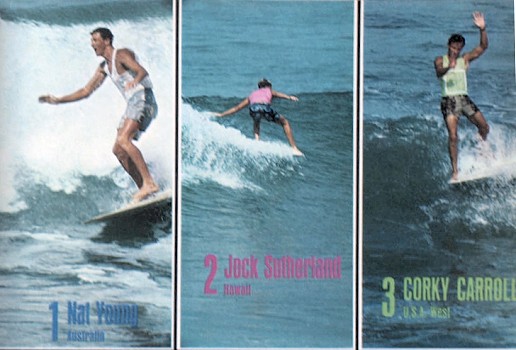
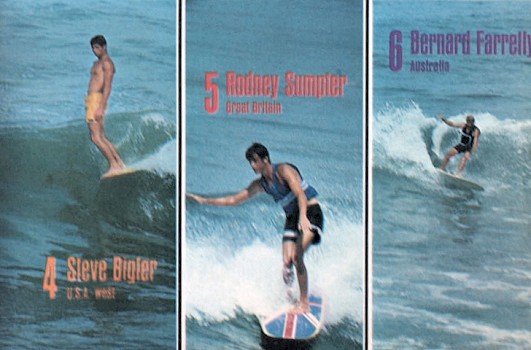
Pages 44-45
One of the
greatest moments in competition surfing history was captured
by Ron Stoner in this incredible 10.1 second nose ride of
David Nuuhiwa in first day competition of the World Surfing
Championships.
David turned
in the longest nose ride in competition history.
The previous
top times were last year at the Tom Morey Noseriding
Invitational by Mickey Munoz, Mike Hynson and Corky Carroll
in 9.9, 9.8, and 9.6 respectively.
However,
they were clocked riding anywhere on the front quarter of
their boards, while Nuuhiwa was hanging five during most of
his wild
ride.
Stoner
caught the action with his motor driven Nikon F with a 385mm
lens.
Later the
camera was clocked by a stopwatch, and it took 10.1 seconds
for the 18 pictures to click off.
An amazing
ride and an amazing photo sequence.
Page 46
Photograph: Corky Carroll drives left during the Sunday finals.
of 193
points for the first two days of competition and made it
mathematically impossible for him to lose in the Sunday
finals.
Even if he
finished last in the finals, Young was the winner.
Contest
officials were dismayed when they realized the lanky
Australian had wrapped up the contest with still two days of
men's competition left.
There was no
question that Young had won fairly and squarely under the
rules set up by the World Championships Competition
Committee.
And yet, as
Australian team official John Witzig put it:
"There's
definitely a flaw in any contest set up so that a champion
can be decided at the half-way point of competition.
It's not his
(Nat's) fault that he scored enough points to win it early.
But the
contest officials should have considered the mathematical
possibility that a red hot surfer like Nat could do the job
in just two days."
NAT OFFERS TO RISK TITLE
Then at a
meeting called by contest officials to discuss the early
victory, champion Young made a probably unprecedented
proposal: He said he was willing to go back in the contest
and risk his points in another day of open heat competition.
This was
tantamount to a heavyweight champion defending his title a
few minutes after winning it, or a golfer again playing the
field after a tournament victory.
"If it will give more suspense to the finals on Sunday, I don't mind risking the title, and besides, I think I'll win it anyway," Young said.
However,
Young's magnanimous offer was scotched by a hastily called
meeting of the International Surfing Federation.
The
officials from all the countries represented voted that
Young indeed had won the title with his impressive showing,
and changing rules in mid-contest would be unfair
Page 47
both to Nat
and the concept of the World Championships.
Therefore,
the contest continued the next day with another full round
of competition, but without champion Young and the
three other
surfers who had been seeded into the finals: Jock Sutherland
in number two position with 144 points; Steve Bigler, with
137 and Corky Carroll with 130.
Bright and
early next morning the contest resumed at Ocean Beach with a
glassy swell in the three to six-foot category rolling under
the pier pilings.
Again there
was great surfing, as the remainder of the field battled to
determine which two surfers would survive and join Young,
Sutherland, Bigler and Carroll in the Sunday finals.
The warfare
was heated, and the list of casualties in the semi-finals
was impressive with names that in other contests frequently
end up on the winner's stand: Among them, Dru Harrison, Kiki
Spangler, 1965 USSA champion Rusty Miller, Paul Strauch,
Jr., David Nuuhiwa, Mike Doyle.
FLETCHER HOT - TOO LATE
The winner
for the third day of men's competition was fluid-riding
Herbie Fletcher of the West Coast team.
But Herbie
had to do it the hard way.
He was
beaten in his semi-final heat by Australia's Midget Farrelly
and found himself in the semi-main with a tough group of
competitors, Gary Propper of the East Coast, Leroy Ah Choy
of Hawaii, and West Coast stars John Peck and Skip Frye.
Herbie
turned in a fine performance in the wind-blown sets and
advanced to the third-day finals.
John Peck
was second in the semi-main, followed by Ah Choy, Frye and
Propper, in that order.
A few
moments later Herbie paddled out into the finals for the
third-day competition- and was just as hot.
There was a
great lineup in the water, and all the contestants were
really scrambling.
When the air
horn sound-
Page 48
ed the end of the 20-minute heat, Fletcher was the winner, followed in order by Peter Drouyn, the Australian junior champion; Hawaii's Jeff Hakman; Rodney Sumpter of England; Midget Farrelly, the first world champion from Australia; and Jackie Ebberly of Hawaii.
However, when total points were tallied for the first three days of competition, the high point men were Farrelly and Sumpter, and they advanced into the Sunday finals to join Young, Sutherland, Bigler and Carroll.
JOYCE CONSISTENT - WINS
The next day the women took the spotlight early for the Sunday finals, and defending champion Joyce Hoffman of Capistrano Beach, California, demonstrated that there is no substitute during a rough week-long contest for consistent performances.
Joyce, who had breezed through
Photograph: San Diego's Skip Frye on one of the great rides at the Mission Bay jetty.
with
first-place victories in the first two days of women's
competition, found the going a little rougher in the hour
long, six-girl final. But she finished high-second to Joey
Hamasaki, her old rival on the United States Surfing
competition circuit.
Thus,
although Joey took the finals, Joyce won the world title by
her accumulated point total for the three days of
competition.
By the time
the six-man men's finals were ready to take to the water,
the beach crowd was growing and people spilled about the
sand and lined the long concrete pier three deep.
San Diego
official, Robert Gilham, estimated that the peak crowd for
the day was 80,000 spectators, and they had plenty to cheer
about during the hour-long finals.
NAT POWERS ON SUNDAY
Nat Young
gave swift notice that he was not there to rest on his
laurels or his two-day point score.
He power
attacked the morning swells unruffled by wind and waves
running up to five feet.
Nat was
given a stiff battle by the other finalists, but left no
doubt that he had come to win- and win he did.
"Nat can
handle any kind of surf- big or small," said Dick Catri,
manager of the surprisingly strong East Coast team.
Catri
pointed out that Young had barely been edged out for the
title in Peru in surf in the 10 to 15-foot category at Punta
Rocas.
Agreeing
was Duke Kahanamoku, the Honorary Chairman of the
Championships, who commented:
"That boy is
really a keen surfer. .. he has a championship look about
him ...I think he's going to be around surfing a long time.
.."
Young's
biggest challenge in the finals was by Corky Carroll and
Jock Sutherland, who finished Sunday's finals in that order.
However, Sutherland moved into second place behind Young in
the overall standings because of his point scores for the
first two days.
Carroll was
third, Bigler fourth, Sumpter fifth and Farrelly sixth.
There was
plenty of frosting on the championship cake.
The
unofficial events included tandem, paddling, dory racing
and-for the first time- explosively exciting catamaran
surfing.
EDWARDS' "CAT" WIPE OUT
The "cats"
were judged in a surfing contest, the first of any known
record, and what a crowd pleaser!
On the very
first takeoff, Phil Edwards dropped his 19-foot "cat" into a
steep five-foot wall, and under full sail, breezed along for
several hundred yards until a crashing section flipped the
boat and smashed the mast.
There were
several other wipeouts in the cat contest that was won by a
boat skippered by Mickey Munoz, Tom Carlyn and Rusty Miller.
Another
crowd pleasing event was the team relay paddle race.
The West
Coast team wrapped up the victory with a strong team of Mike
Doyle, Rusty Miller, Corky Carroll and Steve Bigler.
Demonstrating how an expert water man operates, Miller
assured the victory by catching a wave several hundred yards
from the beach and proning out all the way in to the shallow
water.
NEXT "WORLD" IN HAWAII
As the
competition went into its final moments, there was talk
about the next World Contest.
Where will
it be?
"Hawaii,
probably.
At least we
hope so," said veteran big-wave rider Wally Froiseth, a
judge on the Hawaiian team.
Wally
explained that the International Surfing Federation has
given Hawaii a five-month option on the next World Contest,
and if sponsors in the Islands can be found, that is where
it will be.
Where?
"Probably where the best surf is, maybe even Waimea Bay," said Wally, a twinkle in his eye as if watching some hot dog-oriented surfer going over the falls on a 20-foot wave.
The next
World Contest should be no problem to promote after the
success and world-wide interest of the third competition.
Everyone was stoked.
Said
silver-haired Duke Kahanamoku, 76, who has practically
invented the modern version of surfing:
"Gee, these
kids are really some- thing. ..these suders have really
developed a great sport that ranks with any in the world."
Page 49
Nat Young had some personal views on the World Contest after all the competition had ended and the excitement had died away. Here, in his own words, are some of Nat's views and reflections...
Photograph: [Nat Young and trophy.]
HOW l WON IT
By Nat Young
I am now
World Champion, and I suppose to the normal public, I've
achieved my goal.
Well, I
guess I have as far as contests go, but I feel sure there
are many more directions in surfing not yet looked into.
For me, the
challenge is just beginning.
The third
World Contest looked exactly like those in Peru and
Australia except for two things: the competing surfers were
not bound by a busy schedule of "commercial" obligations.
I'm sure
this pleased all the contestants, because it gave them most
of the day to become acquainted with the surf in the San
Diego area.
But even
more important than this, we had time in the water to surf
and prove our ability by dividing the contest into three
equal parts, instead of a win-or-lose-all battle.
The World
Contest naturally was started to find the world's best
surfer.
In Australia
we found the best in smaller waves.
Last year we
had the best surfer in big waves-and so this year the idea
was to have three separate contests and find the world's
best under all conditions.
However,
something went wrong- the surf didn't cooperate- and we
ended up with two contrasting beach breaks.
In the
first day's surfing at La Jolla Shores, I went well, won my
heat and everything was fine until Hoppy Swarts decided to
move the contest to some jetty about four miles away.
When we
arrived at this new site, my heart really fell as I looked
across the beach and saw a set of lefts.
I rode them,
but so many guys did better.
I wanted a
good right-hander so I could get my power attack going.
The second
day Hoppy, after some time, moved the contest to Ocean
Beach, and at this time, the smaller right was exactly what
I needed after coming in second to Nuuhiwa on Thursday.
I charged,
and with a first and second in the first two days, I felt
pretty confident- I was starting to adjust to world
competition.
The
following day, since I was seeded into the finals, I felt
miserable because I didn't get to surf.
The
challenge of having to fight with Nuuhiwa had disappeared,
and this hurt because I really would have liked to know the
outcome of what could have been a classic battle.
But under
the rules of the contest, I went forward into the finals
while David- who had done poorly the second day- went into
another open heat competition and was eventually eliminated.
I wanted to
have another go at him, but we never faced each other in the
water again.
On Sunday when Hoppy said, "Hit the water," I had several tlioughts going around in my head, and I should have had only one: surfing that contest.
Floundering
through the break, I began to think about the different
attitudes all these so-called best surfers in the world had
towards surfing, and I was wishing I could read their
answers on the questionnaire that all contestants had to
fill out as they registered for the contest.
I wonder
what answers these people put to the question "What does
surfing mean to you?"
How many
were there because they really loved the ocean and the surf?
My next
immediate thought was what do all these surfers try to
achieve in the water.
Or did they
have a plan?
I wrapped up
the championship in two days because I did exactly what I
set out to do- I defined good surfing and then followed my
plan and definition to the best of my ability under the wave
conditions.
I know I
didn't win because I was lucky.
I put a lot
of time into thinking exactly what I wanted to achieve out
there, and I did it.
I remember
discussing this with David Nuuhiwa.
He agreed,
but contradicted himself by going out and attempting to do
one thing perfectly: nose riding.
Don't get
me wrong.
I consider
nose riding very difficult, but it is merely a portion of
modern surfing.
To me modern
surfing involves a number of complex maneuvers expressed in
an individual way, a creative and aggressive style that
reflects your personality.
If you just
stand on the nose from start to finish, you've defeated
creativity and individualism- the very essence of surfing!
At this
point I was interrupted by the penetrating blast of the air
horn, and the finals had begun.
I had ridden
one non-thinking wave and now had to get some power and
move.
Corky came
screaming out of a wave and then Jock Sutherland unleashed a
powerful turn, spraying water all over me.
Three or
four little nothing lefts and then Jock slid into one
beautiful right.
Over inside,
Steve Bigler had one good wave, both feet wrapped around the
end, screaming straight towards Rodney Sumpter who was out
on the shoulder again.
Midget
Farrelly surfed as usual- straight out of the book- taking
time before making any move.
I remember
looking along a nice topped wave and seeing Bigler and
"Gopher" (Sumpter) fighting for the gate.
Bigler won
this time, but what a mess.
Both at
least 20 feet from the pocket.
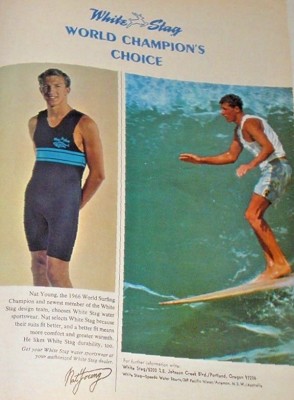 White Stag
Wetsuits, Portland Oregon.
|
The
Color of the Contest
An combination of world contest crowd and fashion
photos by Ron Stoner:
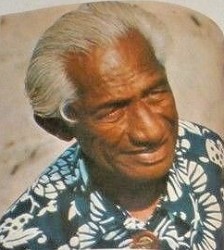 Duke Kahanamoku
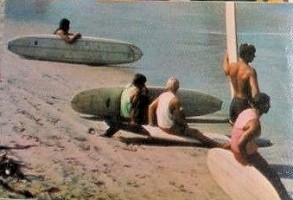 Contestants Contestants
|
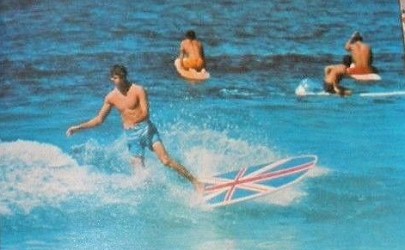 Avalon's Rod
Sumpter, UK.
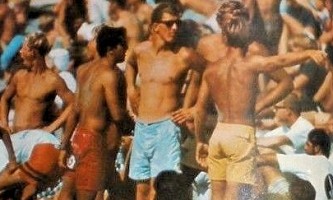 Robert 'Nat' Young and ? |
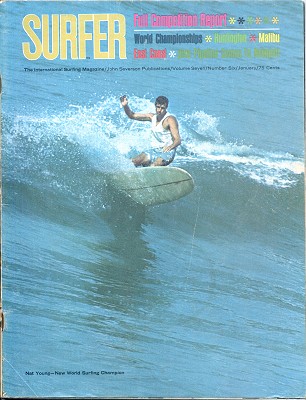 |
Volume 7 Number 6 January 1967 White Stag
Wetsuits, Portland Oregon.
|
 |

| home | catalogue | history | references | appendix |